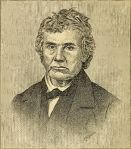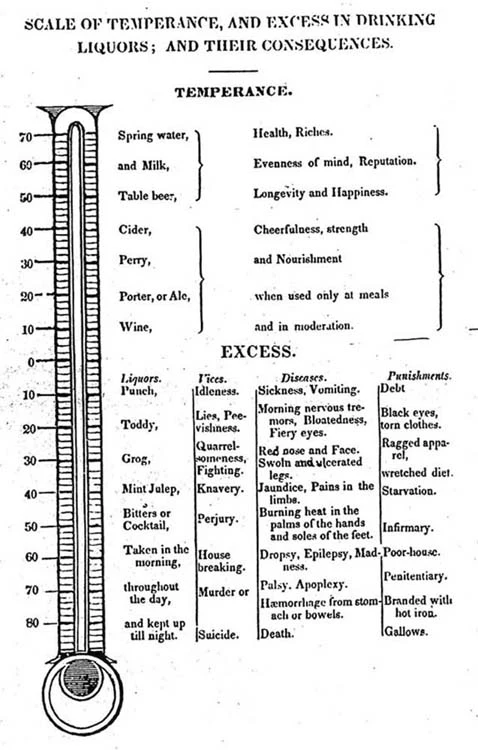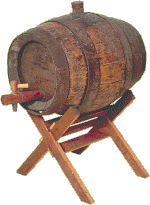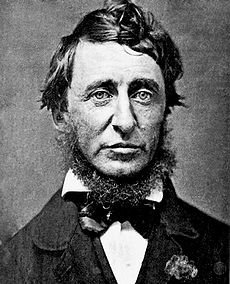 John “Appleseed” Chapman was a propagator of seedling apple trees–trees whose fruit was of unpredictable quality and often too bitter for fresh-eating. While early 19th century farmers could find many home uses for seedling apples, among the most common uses was the production of hard cider. As improved roads and canals began to link more rural Americans into the market economy, the seedling apple tree came under increasing assault, not just from agricultural reformers who disdained it for its lack of commercial value, but also from temperance reformers who viewed it as an important source for alcohol. The following excerpt from Johnny Appleseed and the American Orchard explains how the temperance movement’s war of the poor seedling apple tree emerged:
John “Appleseed” Chapman was a propagator of seedling apple trees–trees whose fruit was of unpredictable quality and often too bitter for fresh-eating. While early 19th century farmers could find many home uses for seedling apples, among the most common uses was the production of hard cider. As improved roads and canals began to link more rural Americans into the market economy, the seedling apple tree came under increasing assault, not just from agricultural reformers who disdained it for its lack of commercial value, but also from temperance reformers who viewed it as an important source for alcohol. The following excerpt from Johnny Appleseed and the American Orchard explains how the temperance movement’s war of the poor seedling apple tree emerged:
. . . by the end of the 1820s, the threat to John Chapman’s seedling orchards was not simply economic and scientific but, increasingly, moral. Fruit from a seedling tree had many uses for a family of course, but in a world where more and more farmers grew food to sell rather than consume, the seedling orchard came to be seen as having just one purpose, the production of hard cider and cider brandy. Per capita alcohol consumption rates in the United States were among the highest in the world in the 1820s, and a temperance movement emerged to combat the evil of drink. Whiskey and other distilled spirits were the focus of many of the early temperance advocates, as their extremely high alcohol content made them the greatest threat. Homemade apple  cider began its life free from alcohol, then gradually fermented to a content of 6 to 8 percent. “New cider” was the term most frequently used for that beverage that had yet to ferment. When the circuit-riding minister Peter Cartwright stopped at an inn for a dinner of hot bread, he and his companion washed it down with “new cider.” It was not until they mounted their horses and renewed their journey that they realized the refreshing beverage they had so eagerly quaffed was not so new, as both men had trouble staying upright on their horses. Because the alcohol content of cider was not enough to ward off the growth of bacteria, cider-makers frequently fortified it with corn whiskey or other distilled spirits to get its alcohol content above 10 or 12 percent. Another common method was to leave the barrels outside on a cold night and scrape off the ice that formed in the top half of the barrel overnight; what was left behind, often called applejack had roughly double the alcohol content.
cider began its life free from alcohol, then gradually fermented to a content of 6 to 8 percent. “New cider” was the term most frequently used for that beverage that had yet to ferment. When the circuit-riding minister Peter Cartwright stopped at an inn for a dinner of hot bread, he and his companion washed it down with “new cider.” It was not until they mounted their horses and renewed their journey that they realized the refreshing beverage they had so eagerly quaffed was not so new, as both men had trouble staying upright on their horses. Because the alcohol content of cider was not enough to ward off the growth of bacteria, cider-makers frequently fortified it with corn whiskey or other distilled spirits to get its alcohol content above 10 or 12 percent. Another common method was to leave the barrels outside on a cold night and scrape off the ice that formed in the top half of the barrel overnight; what was left behind, often called applejack had roughly double the alcohol content.
Some early advocates of temperance viewed hard cider as relatively harmless, even as  a healthful alternative to distilled spirits. Benjamin Rush was among the earliest advocates of moderation in the consumption of alcohol and boasted that a crowd of seventeen thousand who had gathered in Philadelphia on July 4, 1788, celebrated with nothing but beer and cider, “those invaluable federal liquors” in Rush’s construction, in contrast to hard liquor, which he associated with antifederalism. Rush also produced a “moral and physical thermometer” assessing various beverages on their health and moral properties. Water, milk, and “small beer” were at the top and the drinks of the truly temperate, while gin, whiskey, and rum were the beverages of the most dissipated. But Rush placed “Cider and Perry” just below the beverages of the truly temperate and suggested their effects were not all bad–that they produced “Cheerfulness, Strength, and Nourishment, when taken only at meals, and in moderate quantities.” Farm laborers seemed to agree, as farmers who took on hired hands in the harvesting season were expected to provide their workers with a ready supply of hard cider to refresh them and keep up their strength.
a healthful alternative to distilled spirits. Benjamin Rush was among the earliest advocates of moderation in the consumption of alcohol and boasted that a crowd of seventeen thousand who had gathered in Philadelphia on July 4, 1788, celebrated with nothing but beer and cider, “those invaluable federal liquors” in Rush’s construction, in contrast to hard liquor, which he associated with antifederalism. Rush also produced a “moral and physical thermometer” assessing various beverages on their health and moral properties. Water, milk, and “small beer” were at the top and the drinks of the truly temperate, while gin, whiskey, and rum were the beverages of the most dissipated. But Rush placed “Cider and Perry” just below the beverages of the truly temperate and suggested their effects were not all bad–that they produced “Cheerfulness, Strength, and Nourishment, when taken only at meals, and in moderate quantities.” Farm laborers seemed to agree, as farmers who took on hired hands in the harvesting season were expected to provide their workers with a ready supply of hard cider to refresh them and keep up their strength.
In its earliest years, leading advocates of temperance called for moderation in the consumption of alcohol and the avoidance of distilled spirits. But as the movement gained steam in the 1820s, an “ultraist” faction began pressing for total abstention from alcohol. They rejected the view that cider-drinking should be tolerated or seen as a “healthy” alternative to distilled spirits. A man could get drunk on cider as surely as he could on whiskey. “It takes a long time to make a man a drunkard on cider,” one anti-cider crusader declared, “but when made, he is thoroughly made, is lazy, bloated, stupid, cross and ugly, wastes his estate, his character, and the happiness of his family.” Another ultra who campaigned against hard cider claimed its effect on families was often worse than distilled spirits. He cited the wife of a cider-drunkard who had told him that “cider made [the drunkard] more brutal and ferocious in his family. Rum overcame him quicker, laid him prostrate and helpless on the floor, or in the ditch; cider excited him and gave him the rage and the strength of a maniac.”
 By the late 1820s, the ascendant ultraist faction in the temperance movement began to point an accusing finger at the farmer’s seedling apple trees. An article republished in religious and agricultural journals across the country in 1827 raised the question “What Shall I Do with My Apples?” Its author was determined to make the cider apple the newest front in the contest between God and Mammon, declaring that this was a question every Christian farmer should be asking himself. “If he gathers his apples, of course he must make them into cider; and if he makes the cider, of course he must sell it; and if he is to sell it, of course he must sell it to the distiller, or procure it distilled and then sell the brandy; and if the brandy is sold, it must be drank, and in this way every barrel will make and circulate liquid fire enough to ruin a soul, if not destroy a life.” The author of the piece rejected the farmer’s argument that to leave apples to rot was to waste God’s bounty and instead cast the farmer as acting in pursuit of profits in the marketplace at the expense of his neighbors. “If no other market can be found for our cider, but at the still, let it be a matter of conscientious inquiry with every farmer, whether it is right for him to make more cider than he wants for reasonable use in his own family” when he knows his surplus will be distilled into cider brandy and sold to the intemperate. The author of the piece concluded that the only righteous path for the Christian farmer to take in regards to his seedling trees was to “burn them.”
By the late 1820s, the ascendant ultraist faction in the temperance movement began to point an accusing finger at the farmer’s seedling apple trees. An article republished in religious and agricultural journals across the country in 1827 raised the question “What Shall I Do with My Apples?” Its author was determined to make the cider apple the newest front in the contest between God and Mammon, declaring that this was a question every Christian farmer should be asking himself. “If he gathers his apples, of course he must make them into cider; and if he makes the cider, of course he must sell it; and if he is to sell it, of course he must sell it to the distiller, or procure it distilled and then sell the brandy; and if the brandy is sold, it must be drank, and in this way every barrel will make and circulate liquid fire enough to ruin a soul, if not destroy a life.” The author of the piece rejected the farmer’s argument that to leave apples to rot was to waste God’s bounty and instead cast the farmer as acting in pursuit of profits in the marketplace at the expense of his neighbors. “If no other market can be found for our cider, but at the still, let it be a matter of conscientious inquiry with every farmer, whether it is right for him to make more cider than he wants for reasonable use in his own family” when he knows his surplus will be distilled into cider brandy and sold to the intemperate. The author of the piece concluded that the only righteous path for the Christian farmer to take in regards to his seedling trees was to “burn them.”
 Others began to pile on. A correspondent in Cincinnati’s Western Observer said that farmers who raised fruit for the cider and brandy market would only join the temperance crusade “if ever the dictates of conscience get the ascendancy over the mammon of unrighteousness,” framing the problem in the familiar language of a struggle between market-driven capitalism and Christian values. A letter in The Western Recorder condemned “a certain innkeeper for purchasing two barrels of Hard cider for $1.25 each” and selling it to his customers, one of whom “had a bill of $8 charged to him for his portion of the cider, which, at six pence a quart, would amount to thirty-two gallons!” The innkeeper was “a professor of religion” and therefore should have refused to sell alcohol. Instead, he had made a nice profit at the drunkard’s expense. By putting “the bottle to the mouth of his neighbor, [he] has done the deed, and is now calculating . . . on the wages of his iniquity.” The Western Christian Advocate recounted the story of a good temperance man and churchgoer who was regularly in the habit of turning his surplus apples into cider until the day he encountered a neighbor and fellow church member who got drunk on it. Troubled by his complicity in his friend’s downfall, he destroyed his cider press and never made the beverage again.
Others began to pile on. A correspondent in Cincinnati’s Western Observer said that farmers who raised fruit for the cider and brandy market would only join the temperance crusade “if ever the dictates of conscience get the ascendancy over the mammon of unrighteousness,” framing the problem in the familiar language of a struggle between market-driven capitalism and Christian values. A letter in The Western Recorder condemned “a certain innkeeper for purchasing two barrels of Hard cider for $1.25 each” and selling it to his customers, one of whom “had a bill of $8 charged to him for his portion of the cider, which, at six pence a quart, would amount to thirty-two gallons!” The innkeeper was “a professor of religion” and therefore should have refused to sell alcohol. Instead, he had made a nice profit at the drunkard’s expense. By putting “the bottle to the mouth of his neighbor, [he] has done the deed, and is now calculating . . . on the wages of his iniquity.” The Western Christian Advocate recounted the story of a good temperance man and churchgoer who was regularly in the habit of turning his surplus apples into cider until the day he encountered a neighbor and fellow church member who got drunk on it. Troubled by his complicity in his friend’s downfall, he destroyed his cider press and never made the beverage again.
But other campaigners against cider, perhaps conceding that in a contest between piety and profit the latter would ultimately win, began to make the case that taking apples to the cider mill was neither in the farmer’s moral nor in his pecuniary interest. The costs of the hired hands required to gather all of the apples, the efforts to get the fruit to the cider mill, and the fees for processing them into cider were greater than the returns, these writers claimed, as cider fetched such low prices on the market. A more profitable strategy was for the farmer to let the hogs have those apples not fit for fresh eating. Self-provisioning farmers had long followed this practice, as it kept orchard floors clean and their small stock of half-wild pigs fat, and it required little of their scarce labor. But now horticultural improvers converted to temperance promoted fattening hogs on cider apples to a class of farmers concerned with maximizing the revenue on their farms. Those seedling apples lying on the orchard floor could be “converted” to pork with little effort. Both religious magazines and the agricultural journals devoted to improvement enthusiastically embraced the strategy of fattening hogs destined for markets on the old orchard’s windfalls.
By 1829, at least a few farmers had taken the advice of “burn them” to heart. One report circulated in several journals told of a New Haven, Connecticut, gentleman who “ordered a fine apple orchard to be cut down, because the fruit may be converted into an article to promote intemperance.” The editor of the New York Enquirer mocked this wasteful action, opining that “in this age of Anti-Societies, we may soon see the worthless of the land in league, to establish an Anti-Apple and Anti-RyeSociety. Every time and age has its mania:–We hope the world will sober down before dooms-day.” The story of the monomaniacal temperance man destroying apple orchards became part of the folklore of New England and the Midwest, and not only missing orchards  but also abandoned ones were attributed to the zeal of the reformers. Years later, Henry David Thoreau bemoaned the loss of seedling apple trees across the New England countryside. He repeated a story he had heard “of an orchard in a distant town on the side of a hill where the apples rolled down and lay four feet deep against a wall on the lower side, and this owner cut down for fear they should be made into cider.” Thoreau was nostalgic for that time “when men both ate and drank apples, when the pomace heap was the only nursery, and trees cost nothing but the trouble of setting them out,” a time long past when he penned these words in 1859.
but also abandoned ones were attributed to the zeal of the reformers. Years later, Henry David Thoreau bemoaned the loss of seedling apple trees across the New England countryside. He repeated a story he had heard “of an orchard in a distant town on the side of a hill where the apples rolled down and lay four feet deep against a wall on the lower side, and this owner cut down for fear they should be made into cider.” Thoreau was nostalgic for that time “when men both ate and drank apples, when the pomace heap was the only nursery, and trees cost nothing but the trouble of setting them out,” a time long past when he penned these words in 1859.
The number of orchards actually chopped down by temperance ultraists was likely not as great in reality as in local folklore. But the endless moral castigations orchard-owning farmers faced from the temperance crusaders seemed to have an effect. Many a pious farmer was surely troubled by the accusations that by selling apples to cider mills he was serving Mammon instead of God. Many writers attributed the abandonment and neglect of old seedling orchards across New England to the temperance crusade, their owners apparently deciding to forgo the attacks on their moral character by simply neglecting orchards and letting nature swallow them up.
Want to read more? Pick up a copy of Johnny Appleseed and the American Orchard at your favorite bookstore. Also available for Kindle, Nook, and Sony Reader.